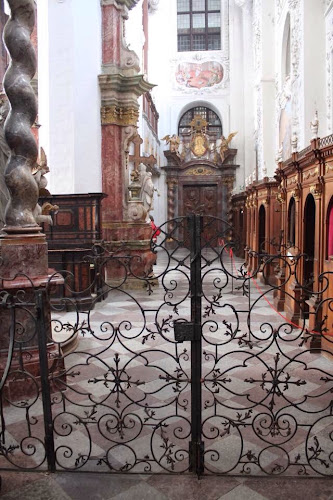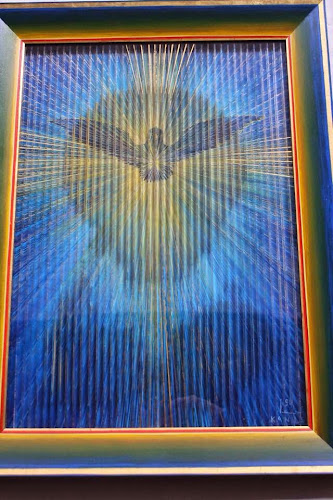Das Kloster wurde im 13. Jahrhundert gegründet als Tochterunternehmen des Klosters Altzella in Sachsen und sollte die Region der Niederlausitz vom Heidentum befreien und für die Kirche ökonomisch erschließen. Hat geklappt. Heute würde man sagen, das Kloster war der größte Arbeitgeber der Region, vermutlich war es der größte Ausbeuter.
Der Gebäudekomplex wurde zwischen 1300 und 1330 auf einem Hügel an der Oderniederung geschaffen. Die Kirche war vom Stil her typisch für die Zeit, Backsteingotik, dreischiffig, eng gesetzte Pfeiler, schmale Seitenschiffe. Das Kloster war wirtschaftlich sehr erfolgreich, 30 Dörfer in der Niederlausitz, einige in der Mark Brandenburg, die Burg Schiedlow und das Städtchen Fürstenberg gehörten den Zisterziensern. Im Jahr 1429 kamen die Hussiten und zerstörten das Kloster und boten den Mönchen an, sich reformieren zu lassen, diese lehnten ab, wurden daraufhin gemartert, ermordet oder verschleppt und werden heute als Märtyrer verehrt, besonders der Abt Petrus. Als die Böhmen wieder weg waren, wurde das Kloster wieder aufgebaut und überstand als katholische Insel die Reformation der Lausitz. Offensichtlich hatten die Mönche ihre Untertanen nicht wirklich überzeugen können, denn die Bauern und Städter aus der Umgebung schlossen sich nach 1550 der Lehre von Martin Luther an. Die neuen Mönche kamen nun aus der Oberlausitz, aus Böhmen und wurden in Prag ausgebildet, das Kloster selbst wurde in die böhmische Ordensprovinz der Zisterzienser aufgenommen. Dann kam der 30jährige Krieg und mit ihm erneute Zerstörung. Nach dem Westpfählischen Frieden kehrten die Mönche zurück, und ließen die wiederhergestellte Kirche von Italienischen Künstlern ausmalen, später dann erfolgte die Barockisierung nach süddeutschem Vorbild. Später kamen die Preußen und das Kloster wurde säkularisiert und in ein Stift umgewandelt, noch später kam die DDR und das Stift wurde aufgelöst. Im Klostergarten entstand eine Laubenpieperkolonie, also kann man jetzt nicht direkt von Fremdnutzung sprechen. Seit 1993 wird umfangreich und aufwändig restauriert und renoviert. Der Klostergarten ist wieder erstanden, ebenso die Orangerie.
Ab 14 Uhr kann man die Kirche besichtigen, sagt die Touristeninformation. Leider ist weit und breit niemand mit dem Schlüssel zu sehen, aber da die Leute alle standhaft blieben und immer irgendwer an der Türklinke rüttelte, hatte dann jemand Erbarmen, gerade als es anfing etwas zu schneien. Also nix wie rein, Begrüßung an der Tür durch folgenden Aufkleber: "Wir bitten herzlich, die Türen zu schließen!" Ja, danke, ich freue mich auch, hier zu sein. Aber das erklärt möglicherweise die zögerliche Öffnung. Und nun tauchen wir ein in barocken Pomp, grandios in seiner Scheußlichkeit. Ich muss sagen, ich bin beeindruckt. Soviel Dekor, Ornamente, Reliefs, Skulpturen, Malereien auf so begrenztem Raum unterzubringen ist phänomenal. Das verdeckt auch die mehrheitlich qualitativ eher fragwürdige, bisweilen hochgradig kitschige Ausführung der Arbeiten. Einige wenige Gesichter wiesen so etwas wie Ausdrucksstärke auf, die meisten schauten eher mehr dümmlich drein. Aber es war halt ein kleines Kloster irgendwo im protestantischen Nirgendwo, vermutlich waren die finanziellen Mittel beschränkt und für ein Gott vergelt's gab es auch früher keine guten Künstler.
Nach soviel Marmor, Gold und Stuck bleibt uns nur die Flucht in den Alkohol. Wir gehen in den Hofladen der Neuzeller Klosterbrauerei, wo das "Schwarzer Abt" gebraut wird und stocken unsere Vorräte auf, Schwarzbier in Flaschen, im Honig, in der Schokolade, in der Seife.....
The monastery was founded in the 13. century as a daughter company of the monastery in Altcella/Saxonia and should lib the Lower Lusatia from pagandom and extrapolate it for the church economic wise. It worked. Today one would say, the monastery was the dominant employer of the region, I would say it was the biggest exploiter.
The buildings were constructed between 1300 and 1330 on a small hill top at the flat valley of river Oder. The style of the church was typical for its time, brick stone gothic, three aisles, the side ones smaller, close-set pillars. The cloister was successful economically, 30 villages in Lower Lusatia and some at Mark of Brandenburg, the castle Schiedlow and the small town Fürstenberg belonged to the Cisterians. In 1429 the Hussite did came and destroyed the cloister and offered the monks to become Protestants, they refused and were tortured, killed or kidnapped and are honoured as martyrs today, especially the abbot Petrus. When the Bohemian left, the buildings were rebuilt and the monastery survived as an Catholic island the Protestant Reformation of Lusatia. Obviously the monks weren't able to convince their subjects, the villagers and citizens all followed 1550 the new doctrine of Martin Luther. The new monks now came from Upper Lusatia, from Bohemia and were trained in Prague, the monastery itself became a part of the bohemian province of the Cisterians. Then followed the Thirty Years War and a second devastation. After the Peace of Westphalia the monks returned and rebuilt the cloister again and charged an Italian artist to do the mural paintings, later the church got baroqued in the style of Southgerman way. Later came the Prussians and the monastery was secularised and turned into a foundation. Much later came the G.D.R. and the foundation was closed, where the cloister garden was, allotment gardens rose up, so it didn't change that much, did it. Since 1993 widespread renovation work was done and the cloister garden and the orangery is reopen now.
At 2pm one is allowed to visit the church, but unfortunately no one with a key is to be seen. But the people remain stood feast and from time to time someone was rattling the door knob and finally some man had mercy and showed up to open just when it started to snow. Come on, let's go! They welcome sign at the door says: 'Dear people, please keep the door shut!' Yes, thanks, I'm too be glad to meet you. But maybe that's the explanation of the very hesitantly opening. And now we dive into baroque pomp, it's splendid in its hideosity. I am impressed. So much decor, ornaments, reliefs, sculptures, mural paintings put in such a limited space is phenomenal. And that nearly makes one forget or oversee the very poor quality or kitschy way of artwork. Very few of the face of the statues got something like an impression on it, the most just had a dull face. But it was a small monastery, somewhere in the middle of the Protestant nowhere and the money was limited and for a 'God may bless you' you won't get good workers, even in the old times.
After that much marble, gold and stucco we seek refuge in alcohol and go and see the brewery shop of the Neuzelle Brewery. Here the brew black beer called 'Black Abbot' and we restock our supplies, black beer in bottles, in honey, in chocolate, in soap....
























































Keine Kommentare:
Kommentar veröffentlichen